Higher classification Prionailurus | Phylum Chordata Scientific name Prionailurus rubiginosus Rank Species | |
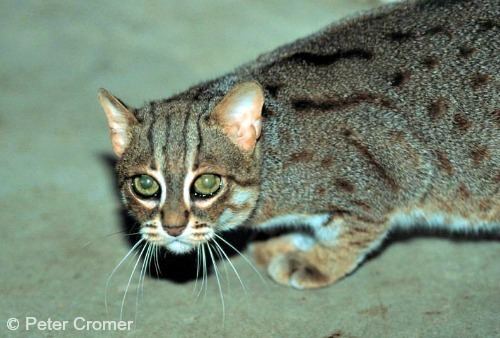 | ||
Similar Black‑footed cat, Geoffroy's cat, Kodkod, Flat‑headed cat, Asian golden cat | ||
Rare rusty spotted cat prionailurus rubiginosus live only in gir forest gujarat india
The rusty-spotted cat (Prionailurus rubiginosus) is one of the cat family's smallest members, of which historical records are known only from India and Sri Lanka. More recently, it was also recorded in the western Terai of Nepal. Since 2016, the global wild population is listed as Near Threatened on the IUCN Red List as it is fragmented and affected by loss and destruction of prime habitat, deciduous forests.
Contents
- Rare rusty spotted cat prionailurus rubiginosus live only in gir forest gujarat india
- Characteristics
- Distribution and habitat
- Distribution of subspecies
- Ecology and behaviour
- Reproduction
- Threats
- Conservation
- In captivity
- Local names
- References
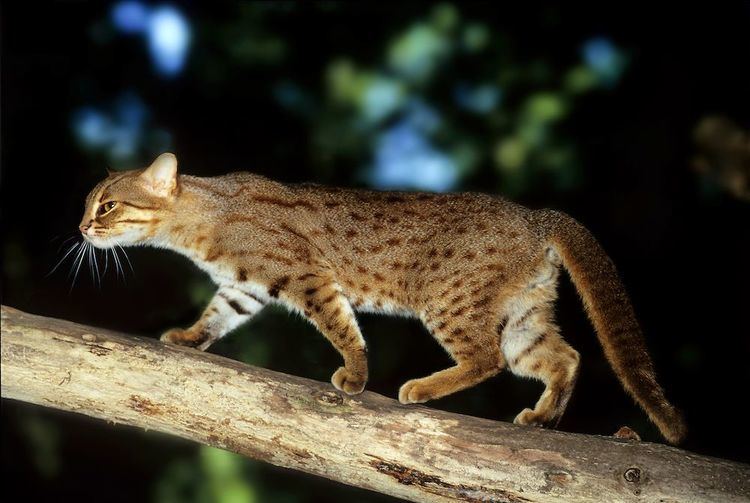
Characteristics
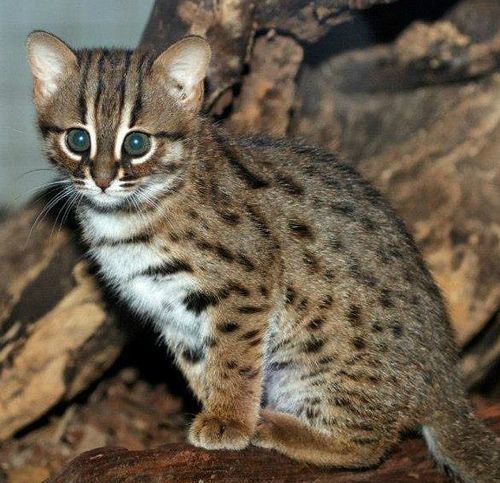
The rusty-spotted cat is the smallest wild cat in Asia and rivals the black-footed cat as the world's smallest wild cat. It is 35 to 48 cm (14 to 19 in) in length, with a 15 to 30 cm (5.9 to 11.8 in) tail, and weighs only 0.9 to 1.6 kg (2.0 to 3.5 lb). The short fur is grey over most of the body, with rusty spots over the back and flanks, while the underbelly is white with large dark spots. The darker colored tail is thick and about half the length of the body, and the spots are less distinct. There are six dark streaks on each side of the head, extending over the cheeks and forehead.
Distribution and habitat
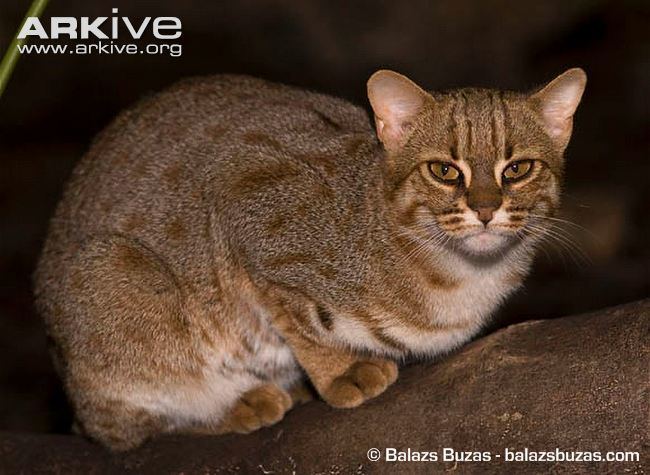
The distribution of the rusty-spotted cat is relatively restricted. It occurs mainly in moist and dry deciduous forests as well as scrub and grassland, but is likely absent from evergreen forest. It prefers dense vegetation and rocky areas.
Distribution of subspecies
Two subspecies are recognized:

In India, it was long thought to be confined to the south, but records have established that it is found over much of the country. It was observed in eastern Gujarat, in the Gir Wildlife Sanctuary and National Park, in the Tadoba-Andhari Tiger Reserve in Maharashtra, and along India's Eastern Ghats. Camera trapping revealed its presence in the Pilibhit Tiger Reserve in the Indian Terai and in the Nagzira Wildlife Sanctuary in Maharashtra. In western Maharashtra, there is a breeding population of rusty-spotted cats in a human dominated agricultural landscape, where rodent densities are high. In December 2014 and in April 2015, it was photographed by camera traps in Kalesar National Park, Haryana.

In March 2012, a rusty-spotted cat was photographed for the first time in Bardia National Park, and in March 2016 also in Suklaphanta Wildlife Reserve, both in Nepal.
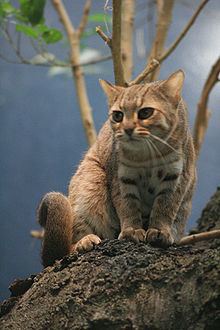
In Sri Lanka, there are a few records from montane and lowland rainforest. There are two distinct populations, one in the dry zone and the other in the wet zone.
Ecology and behaviour
Very little is known about ecology and behaviour of rusty-spotted cats in the wild. Captive ones are mostly nocturnal but also briefly active during the day. Most wild ones were also recorded after dark. Several individuals were observed hiding in trees and in caves.
They feed mainly on rodents and birds, but may also hunt lizards, frogs, and insects. They hunt primarily on the ground, making rapid, darting movements to catch their prey. They apparently venture into trees to escape larger predators. Captive females and males both scent-mark their home range by spraying urine.
Reproduction
Oestrus lasts five days, and mating is unusually brief. Since the female is likely to be vulnerable during this period, its brevity may be an adaptation to help it avoid larger predators. The female prepares a den in a secluded location, and gives birth to one or two kittens after a gestation of 65–70 days. At birth, the kittens weigh just 60 to 77 g (2.1 to 2.7 oz), and are marked with rows of black spots. They reach sexual maturity at around 68 weeks, by which time they have developed the distinctive adult coat pattern of rusty blotches. Rusty-spotted cats have lived for twelve years in captivity, but their lifespan in the wild is unknown.
Threats
Habitat loss and the spread of cultivation are serious problems for wildlife in both India and Sri Lanka. Although there are several records of rusty-spotted cats from cultivated and settled areas, it is not known to what degree cat populations are able to persist in such areas. There have been occasional reports of rusty-spotted cat skins in trade. In some areas, they are hunted for food or as livestock pests.
Conservation
The Indian population is listed on CITES Appendix I. The Sri Lankan population is included on CITES Appendix II. The species is fully protected over most of its range, with hunting and trade banned in India and Sri Lanka.
In captivity
As of 2010, the captive population of P. r. phillipsi comprised 56 individuals in eight institutions, of which 11 individuals were kept in the Colombo Zoo and 45 individuals in seven European zoos.
Local names
In Sri Lanka, the rusty-spotted cat is known as "kola diviya" or "balal diviya".
